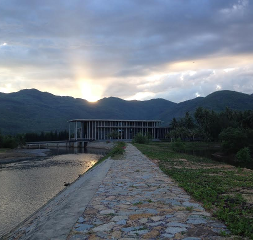Speaker
Description
As Rubakov suggested in 1997, an QCD axion can be heavy if there is a copy of
the Standard Model and a Peccei-Quinn symmetry is realized between it and the
Standard Model.
Following that idea, we construct a concrete model which satisfies the cosmological
consistency.
Then, some of the resultant particles can be around the region which is accessible by
the LHC. We point out that the dilaton in our model can play a role of the diphoton
signal. Although the dilaton-photon-photon coupling is weaker than the dilaton-axion-axion
one, an axion is much lighter than a dilaton and the two photons from an axion is
quite collimated, mimicking a photon signal.
We also investigate how to distinguish this mimicking signal in a preparing work.
Using the information from the tracker, we conclude that using some kinds of
distributions, it is possible to reveal the property.
Summary
We have constracted a model of heavy QCD axion in 1504.06084 and a preparing paper
and discussed the LHC signature associating it with the diphoton signal
in 1602.07909 and one in preparation.
In the talk, I will review how we can make an axion heavy and the validity of the
LHC signature.
